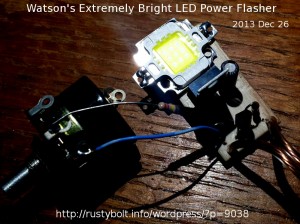Well, the LEDs I ordered more than a month ago have finally arrived. They are 10 Watt(!) 900 lumens from Electronic Goldmine for $6 (USD) apiece (I checked their website and they seem to be sold out). The reason why it took so long was mostly my fault. They were shipped to my previous address, and of course they got sent back to the sender. But I don’t accept total blame: they should make it more clearer where the items are being shipped to. I didn’t see, or else it was so inconspicuous that I didn’t notice where the stuff was being shipped to. I didn’t even remember that I had an account on their website. When they asked to create an account, and I got ‘that account name is already taken” I realized that it was because I had already created an account several years ago, and all I had to do was log in. But I didn’t notice anything with my address, old or new.
 The window on the chip shows an array of 9 LEDs that is three by three. This indicates that three sets of three LEDS in series are connected across the plus and minus terminals. First I connected the LED to the power supply and turned up the voltage. The LEDs started lighting at about 8V or so , so this seems to indicate that three of the LEDs are connected in series. I noticed that two LEDs started to glow before any of the others did. This seems to indicate that those two have a lower forward voltage than the rest. It could mean that not all of the LEDs on the heatsink were properly matched.
The window on the chip shows an array of 9 LEDs that is three by three. This indicates that three sets of three LEDS in series are connected across the plus and minus terminals. First I connected the LED to the power supply and turned up the voltage. The LEDs started lighting at about 8V or so , so this seems to indicate that three of the LEDs are connected in series. I noticed that two LEDs started to glow before any of the others did. This seems to indicate that those two have a lower forward voltage than the rest. It could mean that not all of the LEDs on the heatsink were properly matched.
Then I connected the power supply to a 100 ohm resistor to limit the current to the capacitor, and the 10 000 uF capacitor. For the switch, I touched the LED’s clip lead to the capacitor. I set the power supply to 10 volts to charge the cap. When I touched the clip lead, the LED flashed a blinding bright white flash. Wow, that’s bright.
I plan on using a power transistor to switch the current to the LED, and use the resistor and large capacitor to limit the amount of current it can draw. The power transistor turns on and dumps the charge in the capacitor into the LED, and then the resistor recharges the cap. So about once a second, the LED flashes brightly.
I need to come up with a circuit that has the high current necessary to get the brightest flash from the LED.
Continued in the 2013 Dec 26 blog.











